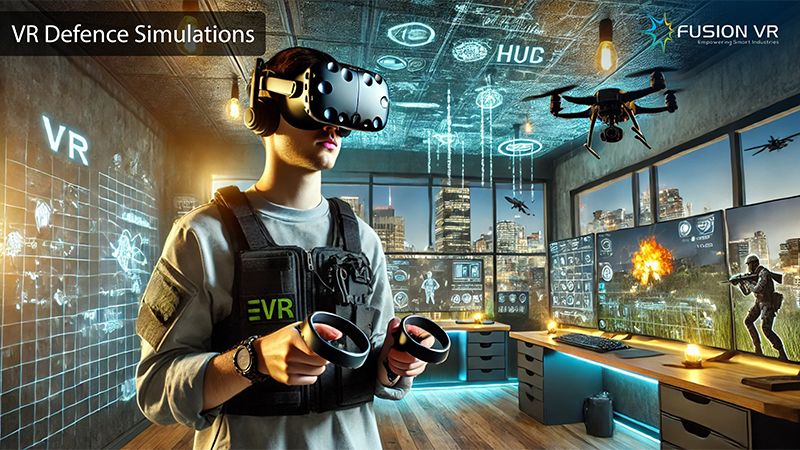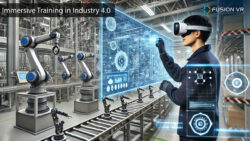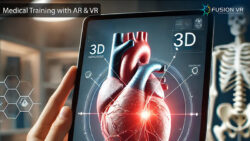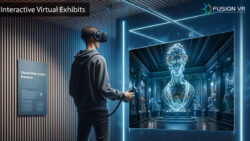VR’s Role in Training on the Rise
Virtual Reality (VR) technology has stormed the modern military training revolution, taking forces away from actually preparing them for combat and strategic missions. The last few years have seen explosive increases in the use of this technology for training, creating realistic combat environments for improving skill and making decisions. As innovative, entry-audit military organizations, VR is increasingly emerging as an indispensable asset for defence preparedness around the world.
Transforming Military Training through Immersive Simulations
Classic forms of military training such as military drills, live-fire exercises and war games usually include heavy physical endurance activities. But such methods take long period of time, budge costly or sometimes involve a risk factor. The revolutionary technology in military training is virtual reality, which offers a soldier an opportunity to be trained under safe immersive environments with realistic conditions and no physical injury at all.
Through VR, the trainees are taken to virtually detailed battlefields recreating original combat environments. The replication could include all kinds of atmospheric condition variables, terrain challenges, and even enemy engagements, thus allowing for some of the best imitative training. By means of VR headsets and motion-tracking systems, soldiers can simulate a virtual environment, showing movement through terrains, combat with opponents enlivened by artificial intelligence, and tactical maneuvers in a purely controlled pattern.
Cost-Effective and Scalable Training Solutions
The most significant advantage of VR in using defence training is that it tends to be cost-effective. Physical training exercises are large in terms of logistics, ammunition, and physical resources, and, therefore, very expensive and resource-intensive. With VR, most of these costs vanish, as training can be done so easily without much physical activity in the digital alternative.
Additionally, the training is very easy to scale up, allowing a group of trainees at different training centers to join the training at the same time. It is especially useful in large military units where personnel need to be trained simultaneously without being constrained by geography. Here, cloud-delivered virtual reality enables soldiers stationed in different bases or even countries to participate in the same training exercise.
Enhancing Tactical and Strategic Decision-Making
Combat-specific conditions often impose decision speed and decision accuracy requirements on use of weapons and equipment. With state-of-the-art VR-based unique training scenarios created for military personnel, their ability to handle high-pressure, real-life situations does develop practice of quick thinking and adaptability. An example is that of simulation of hostage rescue, counter-terror missions, or even urban warfare together thrown at soldiers as they challenge their ability to respond to unpredictable threats.
In addition, commanders and strategists can use virtual reality (VR) to evaluate battlefield scenarios, keep track of enemy locations, and put various operational plans through their paces in virtual reality prior to implementation. Such all-around strategic planning can help a mission become significantly more successful and reduce casualties.
Specialized Training for Different Defence Sectors
It addresses not just the ground forces of defence training, but also extends to the air force, navy, marine and special operations forces as well. An example is the following.
- Aviation Training: Pilots can also be subjected to very realistic simulations of air combat, emergency landings, aerial tussles, and successful counter-parts. Modern advanced VR systems can now mimic environments within different aircraft cockpits, enabling pilots to familiarize themselves with the controls and operations before they fly any mission.
- Naval Training: It prepares the naval officer and sailor for practice in ship navigation, submarine operations, and maritime combat situations. It also considers the aforementioned preparation using various scenarios of emergency, including fire outbreaks, evacuation from a ship, and underwater rescues.
- Special Forces Training: Commandos and counter-terrorism units can make use of VR technology for mission rehearsals, hostage rescues, or urban warfare scenarios. Such reality-based mission environments with high fidelity provide mission readiness and efficiency.
VR for Medical and Psychological Preparedness
VR or virtual reality is not only intended for combat training but is also now used in military medical training. Using virtual simulations, medics and field doctors could practice trauma response, first aid, and emergency surgery on-site. Such scenarios help medical personnel prepare for high-stress conditions in treating real cases.
Also, this virtual reality part has a huge impact on overall mental wellbeing of soldiers. Exposure to combat stress really breeds a number of psychological challenges and PTSD, which a soldier will suffer from. For the soldiers, effective therapy programs are being developed which in turn will allow the soldiers to relive the trauma through exposure and simulation therapy techniques.
Integration of AI and Haptic Technology in VR Training
In fact, the whole future of VR training is becoming even more promising when it gets supplemented with artificial intelligence and haptic feedback technology. AI-imbued virtual foes act like people, learn from the trainees’ actions, and evolve the training scenarios further into a much more dynamic and less predictable experience for them. Soldiers, therefore, must keep developing their tactics for being in constant challenge.
Haptic technology provides experiences that feel real when one interacts in a virtual environment and is soon improving how VR is training users to prepare for real war. With such haptic suits and gloves, trainees will be able to experience what happens with gun recoil, explosions, and the loading weight of gears in switching scenarios.
Global Adoption and Future Prospects
VR acquired as a standard component in most of the defence organizations around the world. It invested in countries like the United States, the United Kingdom, China, and into India in military training systems based on VR. From allied defence contractors to the best tech companies, they all join forces to come up with the most advanced VR solutions that are specifically made for defence applications.
Conclusion
The evolution of virtual reality in defence training has ushered in progress as far as military preparedness is concerned. Immersive, affordable, and scalable training will radically transform the ways in which soldiers, pilots, naval officers, and medical personnel practice their engagement in different types of combat and crisis settings. The future of military training appears to be as advanced as global defence organizations continue to pick up and refine the technology. This means that the armed forces will be more fit than ever to face the challenges of modern warfare.





